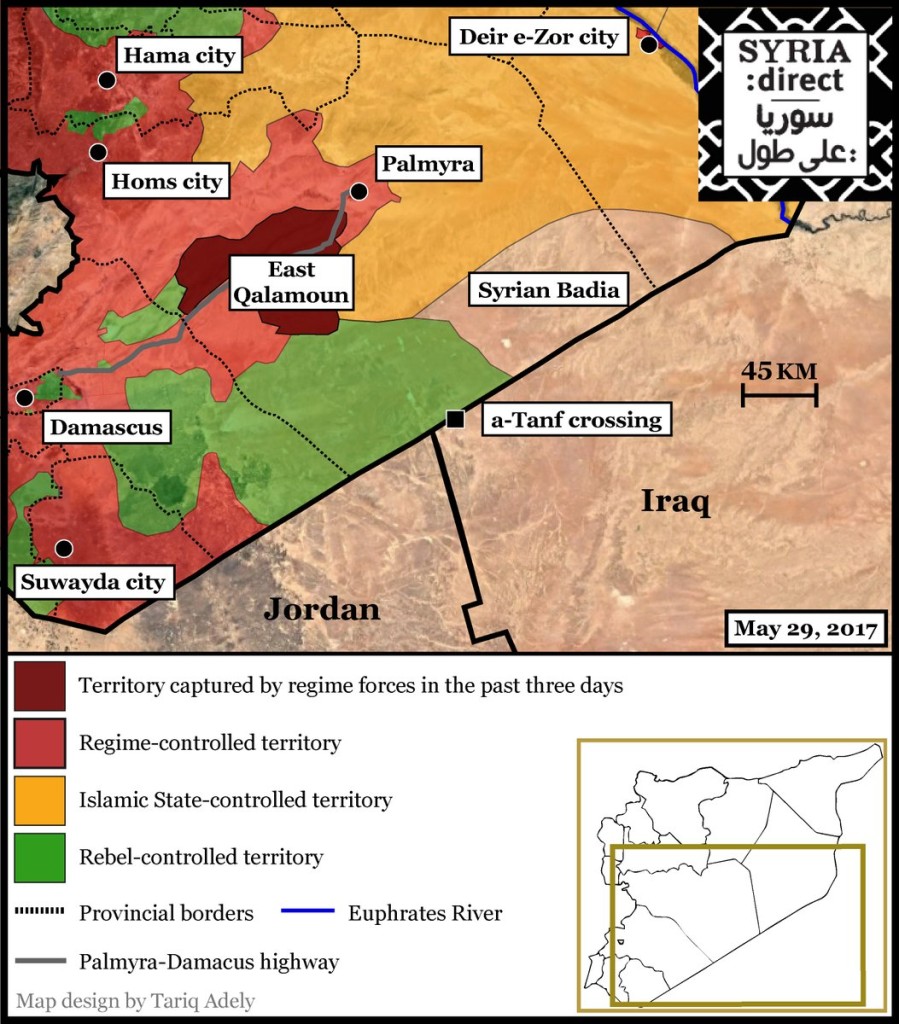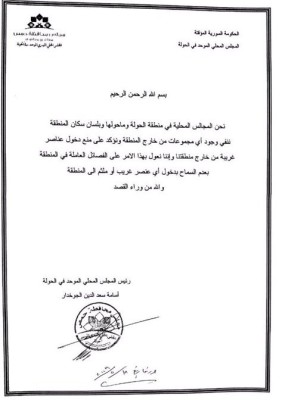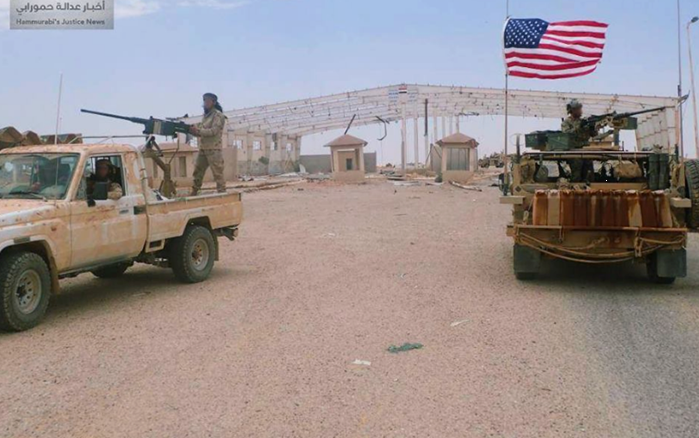Rebels says US support increases amid possible Iran route for weapons from Iraq into Syria
LATEST
- Video: Ongoing Bombing by Regime Forces Inside Hama “De-Escalation Zone”
- Report: 1000s of Syrians Cut Off from Medical Treatment After Turkey Imposes Quota
- Residents of Houla Fear Another Mass Killing by Regime Forces
UPDATE 1115 GMT: Pro-opposition activists says the Free Syrian Army has pushed back Iranian-supported foreign militias in an overnight counter-attack, forcing the pro-Assad force to withdraw to about 100 km (62 miles) from the town of Tanf and the nearby base near the Iraq border.
Footage of the FSA attack with Grad rockets:
#Syria: #FSA shelling pro-#Assad forces in the Southern #Syria|n Desert with Grad rockets. Near #Zaza Checkpoint.https://t.co/aFx3q5g2TG pic.twitter.com/srHIdI8Fuj
— WorldOnAlert (@worldonalert) May 31, 2017
ORIGINAL ENTRY: Syrian rebels say the US and its allies have stepped up supplies to them in the southeast, helping them defend against possible attacks by a pro-Assad offensive trying to advance along the vital highway from Iraq through Syria.
“There has been an increase in the support,” said Tlass Salameh, head of a Free Syrian Army faction. “There’s no way we can let them open the Baghdad-Damascus highway.”
The declaration raises the question as to whether the US will back the rebels beyond a 55-km (34-mile) exclusion zone around the Tanf base near the Iraq border, whether American special forces train and assist the Free Syrian Army.
See also Syria Daily, May 30: The Looming Battle in the Eastern Desert
Two weeks ago the US carried out its first airstrikes against pro-Assad forces — including Hezbollah and Iranian-supported militia — when the advance moved inside the zone and threatened to establish a forward position. However, the US military has said the action is defensive, and rebels have reconfirmed that the Americans are backing offensive operations only against the Islamic State and against the Assad regime’s military and its allies.
But the advance of pro-Assad forces against the Islamic State in recent days may raise the issue of whether the exclusion zone will be expanded. Moving southeast of the city of Palmyra through the Badia, a sparsely-populated desert region, the offensive has taken more than 1,100 square km and is trying to take the highway running to Deir ez-Zor Province, where regime forces have been surrounded by ISIS since 2014.
Successful operations would provide the first ground route for Iranian weapons through Iraq into Syria. Inside Iraq, Iranian-backed militias have been taking villages west of the town of Tal Afar from ISIS and are now only 20 to 25 km (12.5 to 15.5 miles) from the border.
The opening of the route could concern the US military, who want to restrict Iran’s freedom of action in the region, including provision of weapons to Hezbollah as well as the Assad regime. Since the start of the Syrian uprising in March 2011, Iran has had to prop up the regime’s military through air supply.

Map: Tariq Adely/Syria Direct
Rebel Commander: Anti-Tank Missiles and Armored Vehicles Delivered
A senior commander of the FSA faction Maghawir al-Thawra said weapons have been arriving at the Tanf base since pro-Assad forces deployed for their offensive early in May. He also said recruiting and training of local fighters had accelerated.
“The equipment and reinforcements come and go daily…but in the last few weeks they have brought in more heavy military vehicles, TOW [anti-tank missiles], and armored vehicles,” he told Reuters.
A rebel source sent photos showing two newly-delivered armored vehicles and fighters unpacking mortar bombs.
A spokesman for the US-led coalition, Colonel Ryan Dillon, would not say if support had increased, restating that the force at Tanf were “prepared to defend themselves if pro-regime forces refuse to vacate” the zone around the base.
A foreign commander in the pro-Assad forces maintained that the offensive in the Badia would “obstruct all the plans of the MOC [US-led Military Operations Center], Jordan and America” to block “what they call the Crescent” from Iraq through Syria.
The head of the Iranian-backed Iraqi Badr militia, Hadi al-Amiri, asserted that its advance would help the pro-Assad forces to reach the Iraq-Syria frontier: “The Americans will not be allowed to control the border.”
US Military Confirms Arms Supply to Kurdish Militia YPG
The US military has confirmed its arm supply to the Syrian Kurdish militia YPG, even though Turkey considers the faction part of the “terrorist” Turkish Kurdish insurgency PKK.
Pentagon spokesman Major Adrian Rankine-Galloway said the YPG received small arms and vehicles on Tuesday.
The US has discreetly supplied the YPG since late 2015 when the Syrian Democratic Forces, led by the Kurdish militia, was created to fight the Islamic State in northeast Syria. However, Washington has only acknowledged the arrangement this month, with Donald Trump signing an order openly authorizing the deliveries.
The SDF has advanced steadily against ISIS, moving through northeast Syria and west of the Euphrates River despite a Turkish “red line”. However, there have been months of political wrangling over whether the YPG would be involved in the SDF’s offensive to take Raqqa, the Islamic State’s central position in northern Syria.
Through the spring, the US has moved towards support of the offensive despite Ankara’s opposition. American airstrikes, special forces, and weapons have backed the SDF’s capture of the town of Tabqa, 40 km (25 miles) west of Raqqa, and its nearby dam, the largest in Syria.
TOP PHOTO: Free Syrian Army and US fighters at the Tanf border crossing between Syria and Iraq
Video: Ongoing Shelling by Regime Forces Inside Hama “De-Escalation Zone”
Video of ongoing regime shelling near Latamneh in northern Hama, despite the Russian-declared “de-escalation zone”:
Pro-opposition activists say the regime attacks are systematically trying to burn crops, limiting food in the Latamneh area.
Regime forces have not halted bombing and shelling of the area since Russia, Turkey, and Iran proclaimed the de-escalation zone in early May.
Report: 1000s of Syrians Cut Off from Medical Treatment After Turkey Imposes Quota
Thousands of Syrians have been denied medical treatment after Turkish authorities began enforcing a quota, allowing only five “non-emergency” patients across the border each day for care, according to sources in Idlib Province in northwest Syria.
Up to 3,000 cancer, heart disease, and kidney failure patients are waiting at the border, said Ahmad Abu al-Reik, an administrator in the Bab al-Hawa border crossing’s hospital, on Tuesday.
Abu al-Reik said about 60 Idlib residents crossed the border before the quota was imposed on May 18.
Turkey did not announce any reason for the quota, but al-Reik said Turkish officials said “sick people and those accompanying them [were] failing to come back home to Syria after receiving treatment”.
The official website of Bab al-Hawa had announced a temporary closure policy on April 20, barring all crossings “until further notice” for those needing non-emergency medical treatment.
Residents of Houla Fear Another Mass Killing by Regime Forces
Thousands of Syrians are “shut off” from medical treatment after Turkish authorities began enforcing a quota earlier this month, allowing only five “non-emergency” patients across the border each day for care, sources in Idlib province tell Syria Direct.
As many as 3,000 cancer, heart disease and kidney failure patients are now literally waiting at the border for treatment, Ahmad Abu a-Reik, an administrator in the Bab al-Hawa border crossing’s hospital told Syria Direct on Tuesday. Bab al-Hawa is the only open border point between Syria’s Idlib province and Turkey.
Under the new Turkish policy, it would take at least 85 weeks—or almost a year and a half—for all 3,000 current patients to be able to leave Syria for treatment.
It is unclear who exactly is now in charge of determining which five patients are allowed through the border per day, but the hospital a-Reik helps run is the last stop for thousands of people with “non-emergency” illnesses such as cancer, kidney failure and heart disease. There, medical staff treat and diagnose patients on Syrian soil before deciding whether to transfer them to larger facilities in Turkey for more comprehensive care, including chemotherapy and heart catheters.
With no hospitals equipped to treat the seriously ill at home in Syria’s embattled, rebel-controlled Idlib province, patients rely on the Bab al-Hawa border crossing to reach facilities across the border in Turkey.
Before the five-patient quota, an estimated “60 Idlib residents per day” would cross into Turkey, a-Reik said.
But on May 18, Turkish authorities reportedly imposed a limit of five non-emergency patients per day to enter for treatment, a-Reik said—meaning that anyone in need of life-saving care across the border in Turkey’s Hatay province is added to a backlog of around 3,000 other people awaiting their chance to travel through the Bab al-Hawa crossing.
Turkish media did not report the newly imposed quota. An official website affiliated with the Bab al-Hawa crossing, which is controlled on the Syrian side by the Islamist armed group Ahrar a-Sham and releases new border policies on a regular basis, also did not share news of the new limit.
Residents of Houla Fear Another Mass Killing by Regime Forces
Residents of Houla, near Homs city, have expressed fear of another mass killing by regime forces.
The local council has issued a statement that there has no Islamic State presence in the village since 2014, countering regime justification of an attack to eliminate “terrorists”.
Activists say leaflets dropped on the village tell residents, “The decision to eliminate terrorism and the hour of your salvation from this criminal organization is approaching,” and call on rebels to disarm: “Your destiny is inevitable No one can beat the Syrian Arab Army.”
In May 2012, the Syrian military killed more than 100 civilians, including 40 children, and wounded about 300 as they swept through Houla.
The statement from the local council:


